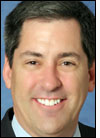Most hospitals use telemetry monitors that transmit a patient’s health data over a proprietary system to antennas installed for those monitors. Such telemetry systems have been in place for decades, but they have limitations—the monitoring data is received only in locations where antennas are installed for that specific application. That can be cumbersome and expensive, according to medical technology firm Draeger , which has developed its own system by which telemetry monitors that utilize built-in Wi-Fi technology to transmit data to a central monitoring server via a hospital’s existing Wi-Fi infrastructure. There is no location-tracking feature built into Draeger’s system; however, the addition of tracking software would make it possible to use a facility’s existing Wi-Fi access points to determine the monitor’s exact location within that facility.
The Kaweah Delta Medical Center, located in Visalia, Calif., is one of approximately 100 North American hospitals employing the Draeger system. In early 2009, Kaweah Delta began using its existing Cisco Wi-Fi Unified Wireless Network with Draeger’s M300 patient-worn telemetry monitors, in order to track its cardiac patients’ health in real time.
As the hospital grows, greater functionality is being added to its existing 802.11 wireless local area network, including not only monitoring the health of individual patients based on heart-monitor data, but also tracking the location data from iPads and other Wi-Fi-enabled handheld devices, such as voice-over-IP (VoIP) phones and IV pumps, using the medical center’s own back-end management software. Draeger provides the telemetry-monitoring M300 devices, as well as its Infinity Central Station server and software, on which information is received and displayed for hospital staff members to monitor patients’ health from a central location within the facility.
Kaweah Delta expanded its hospital with a 250,000-square-foot Northern Expansion project for cardiac care in December 2008. At that time, the medical center was utilizing a proprietary telemetry system that provided coverage only in some parts of the four-block campus. Knowing the system would need to grow with the expansion, as well as be updated to provide more complete coverage, the hospital began evaluating its options. The bigger a facility is, the costlier a proprietary telemetry system can be, since additional receivers and antennas need to be installed, according to Tim Weinmann, s market-development manager for wireless patient monitoring, at Draeger Medical, one of the company’s U.S. divisions. An antenna system for receiving health status data transmitted by patient-worn traditional telemetry devices, he says, costs an average of $1.50 to $3 per square foot of coverage.
Kaweah Delta selected a Wi-Fi-enabled solution from Draeger that allows telemetry monitors to transmit data to the hospital’s existing wireless nodes, which then route the monitor data to Draeger’s Infinity Central Station software. There, the information can be viewed by the facility’s “tele techs,” who are trained to recognize potential heart problems based on the monitor data, says Dave Gravender, Kaweah Delta Medical Center’s chief information officer.
This solution costs considerably less than a proprietary telemetry system, the hospital reports, since no specialized telemetry receiver antennas need to be installed. Instead, the facility purchases the M300 patient-worn telemetry monitor device, including sensors, and the Infinity Central Station back-end software and server, to interpret vital-signs data, display that information on monitors for the tele techs, and trigger alerts if the health statistics change, or if a sensor goes out of the network.
Installing a solution that utilized Kaweah Delta’s existing Wi-Fi network not only was less expensive, Gravender explains, but also provided better read coverage than the previous proprietary system did. With the old system, he says, the hospital was “restricted to providing the monitoring wherever an antenna went.” Kaweah Delta is sited on an open campus, however, with multiple buildings and open spaces between that required telemetry coverage. To provide coverage throughout the four-block campus, the Wi-Fi system can receive transmissions from Draeger’s telemetry devices at any location throughout the hospital campus—both indoors and outdoors.
The hospital employs about 140 M300 telemetry monitors, each worn on a lanyard around a patient’s neck. The device is wired to sensors that adhere to a patient’s skin. These sensors capture electrocardiogram heart rate and sp02 (blood oxygen level) data about the wearer, and forward that information to the M300 device, which displays the latest results on a screen on its face. The device also sends the same information, along with its own unique identifier, to the Wi-Fi nodes, that then route the data to a server running the Infinity Central Station monitoring software. A single Central Station server can manage data from up to 32 telemetry monitors.
Upon providing an M300 to a new patient, employees input that individual’s ID number and related health details into the Infinity Central Station software, where it is linked with that device’s unique ID.
As the monitor is worn by a patient, the software displays the sensor data on screens in the hospital’s monitoring area for tele techs to view. What’s more, the screens display alerts in the event that a problem arises, such as a change in the patient’s sensor readings. That alert is received by the M300 device belonging to that particular patient, which sounds an audible alert so that nearby staff members can respond immediately. The monitors also display the patient’s name, medical details and room assignment.
To take further advantage of its Wi-Fi system, the hospital has added other parallel functions as well, such as tracking the amount of medication each of 390 Alaris IV pumps—which have built-in Wi-Fi functionality—administers to a patient, and at what rate. “It’s a living project,” Weinmann states. Once the Wi-Fi infrastructure is in place, he says, “a hospital can continue adding functions.”
Although Kaweah Delta uses Cisco Wi-Fi nodes, Weinmann says, the M300 can operate with nodes supplied by many other Wi-Fi system providers.



